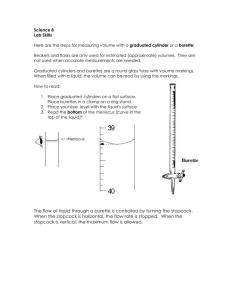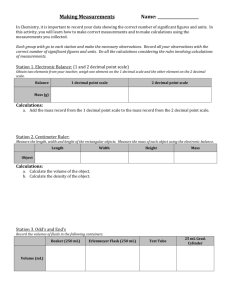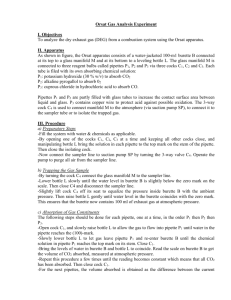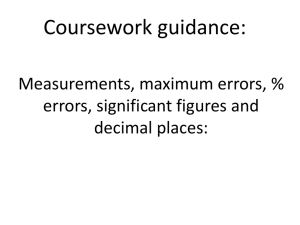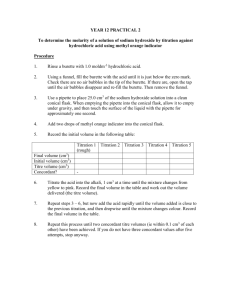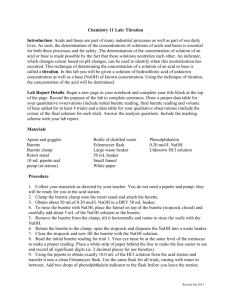1.0 Calibration of Volumetric Glassware 1.1 Introduction: Calibration
advertisement
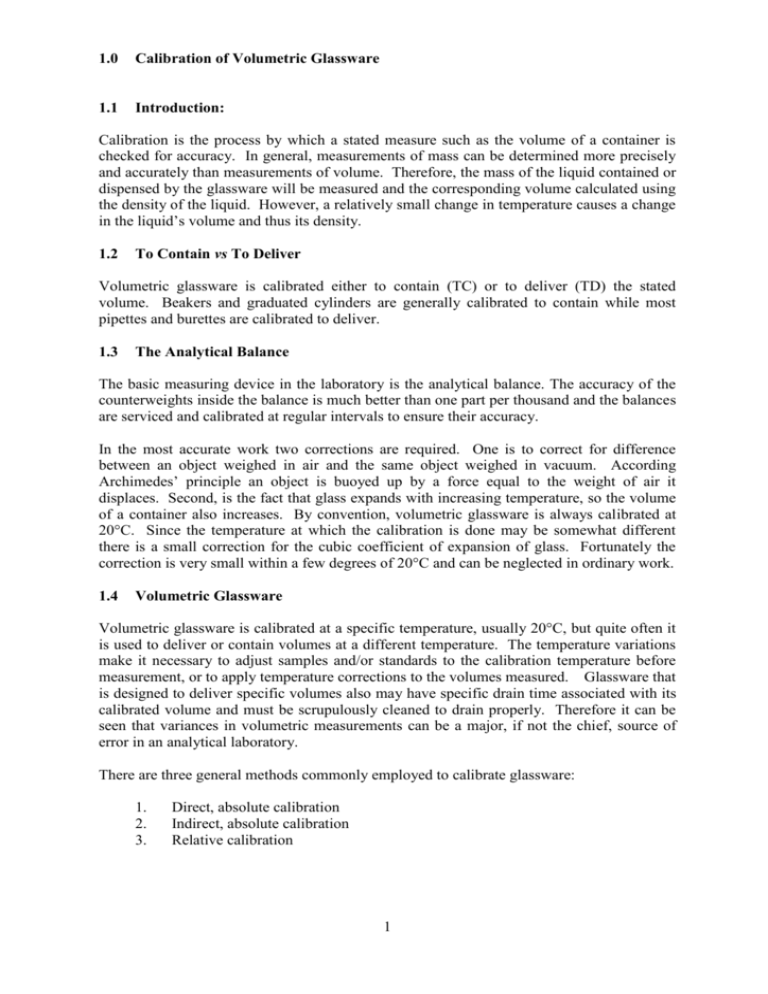
1.0 Calibration of Volumetric Glassware 1.1 Introduction: Calibration is the process by which a stated measure such as the volume of a container is checked for accuracy. In general, measurements of mass can be determined more precisely and accurately than measurements of volume. Therefore, the mass of the liquid contained or dispensed by the glassware will be measured and the corresponding volume calculated using the density of the liquid. However, a relatively small change in temperature causes a change in the liquid’s volume and thus its density. 1.2 To Contain vs To Deliver Volumetric glassware is calibrated either to contain (TC) or to deliver (TD) the stated volume. Beakers and graduated cylinders are generally calibrated to contain while most pipettes and burettes are calibrated to deliver. 1.3 The Analytical Balance The basic measuring device in the laboratory is the analytical balance. The accuracy of the counterweights inside the balance is much better than one part per thousand and the balances are serviced and calibrated at regular intervals to ensure their accuracy. In the most accurate work two corrections are required. One is to correct for difference between an object weighed in air and the same object weighed in vacuum. According Archimedes’ principle an object is buoyed up by a force equal to the weight of air it displaces. Second, is the fact that glass expands with increasing temperature, so the volume of a container also increases. By convention, volumetric glassware is always calibrated at 20°C. Since the temperature at which the calibration is done may be somewhat different there is a small correction for the cubic coefficient of expansion of glass. Fortunately the correction is very small within a few degrees of 20°C and can be neglected in ordinary work. 1.4 Volumetric Glassware Volumetric glassware is calibrated at a specific temperature, usually 20°C, but quite often it is used to deliver or contain volumes at a different temperature. The temperature variations make it necessary to adjust samples and/or standards to the calibration temperature before measurement, or to apply temperature corrections to the volumes measured. Glassware that is designed to deliver specific volumes also may have specific drain time associated with its calibrated volume and must be scrupulously cleaned to drain properly. Therefore it can be seen that variances in volumetric measurements can be a major, if not the chief, source of error in an analytical laboratory. There are three general methods commonly employed to calibrate glassware: 1. 2. 3. Direct, absolute calibration Indirect, absolute calibration Relative calibration 1 1.4.1 Direct Calibration A volume of water delivered by a burette or contained in a volumetric flask is obtained directly from the weight of the water and its density. For example, if at 25°C, a 20.00 ml pipette delivered 19.970 g of water then the volume delivered at 25°C would be 19.970 g x 1.0040 ml/g = 20.05 ml. At 20°C the volume would be 19.970g x 1.0037 ml/g = 20.04mL. (See table in Section 3.0 on page 3 for temperature specific values for water density) 1.4.2 Indirect Calibration Volumetric glassware can be calibrated by comparison of the mass of water it contains or delivers at a particular temperature with that of another vessel which had been calibrated directly. The volumes are directly related to the masses of water. This method is convenient if many pieces of glassware are to be calibrated. 1.4.3 Relative Calibration It is often necessary to know only the volumetric relationship between two items of glassware without knowing the absolute volume of either. The situation arises, for example, in taking an aliquot portion of a solution. Suppose that it is desired to titrate one-fifth of an unknown sample, the unknown sample might be dissolved and diluted to volume in a 250 ml volumetric flak. A 50 ml pipette would then be used to withdraw an aliquot for titration. For the calculation in this analysis, it would be necessary to know the exact volume of the flask or the pipette, but it would not be necessary to know the exact volume of the flask or the pipette, but it would be required that the pipette deliver exactly one-fifth of the contents of the flask. The method used for the relative calibration in this case would be to discharge the pipette five times into the flask and marking the level of the meniscus on the flask. 1.5 In Conclusion The use of calibrated glassware is of great importance in a chemical laboratory in order to ensure that any volumes measured are known with a certain degree of accuracy. 2.0 Methodology 2.1 Calibration of Burette Record the temperature in the laboratory Wash the supplied burette thoroughly such that no drops of distilled water are left on the internal surface of the burette. If droplets of water are still observed to adhere to the inner surface of the burette after delivering deionised water, the burette must be considered as still dirty and the cleaning process repeated. Allow the burette to drain for some time. Clean and dry a small flask using paper towels and a stream of warm air. Handle the flask using the paper towels since fingerprints and sebaceous oils may cause the calibration process to be imprecise. Fit the flask with a stopper. Weigh the flask on an analytical balance to the nearest 0.1 mg. Using a transfer pipette, rinse the burette with distilled water at room temperature. 2 3.0 Drain the burette completely into a beaker. Place the burette into the burette clamp. Ensure that the clamp is mounted tightly and is level. Using a funnel, re-fill the burette was with deionised distilled temperature equilibrated water. Ensure that the burette is not over-filled. (The burette must be filled to slightly past the 0.00ml mark.) Carefully wipe off any solution spilled on the outside of the burette. Open the stopcock and drain the burette to the 0.00ml mark. Ensure that no air bubbles are present in the burette or in the stopcock tip. If any are present, the burette must be re-drained slightly to force out the air bubbles and refilled. Touch the beaker to the tip of the burette to remove any adhering drops of water. Allow the burette to stand for 5 minutes. If the level of the burette has changed, more water must be added slowly, to reach the 0.00ml mark. Place the flask under the burette. Open the stopcock and slowly transfer 10ml into the flask Touch the tip of the burette to the wall of the flask. Allow the flask to stand for 30 seconds such that the film of liquid on the walls of the burette to drain. Stopper the flask in order to prevent evaporation. Record the apparent volume of liquid extracted from the burette to the nearest 0.01ml. Weigh the flask to the nearest 0.1mg. Repeat the procedure in 10ml increments, all the way to 50ml. Refill the burette was re-filled and repeat the entire procedure for a further 2 times. Record your results onto the tables provided in Section 3.0 below. Refer to the definitions included at the end of Section 3.0 prior to recording your results. Estimate the Standard Deviation, Precision, and Absolute and Relative Error of these results. Comment on the significance of these results Results Water temperature: Density of water (from table): Density of Water Temperature (°C) 19 20 21 22 23 24 25 26 Density (g/mL) 0.9984082 0.9982071 0.9979955 0.9977735 0.9975415 0.9972995 0.9970497 0.9967867 3 Corrected volume of 1 g of water at 20(°C)* (m/L) 1.0027 1.0029 1.0031 1.0033 1.0035 1.0038 1.0040 1.0042 Interval 0-10ml Final Reading (ml) Initial Reading (ml) Apparent Volume (ml) Mass Actual Volume (ml) Correction Average Correction for interval 0-10ml: Consequently, the burette delivers ------------ml less than indicated by the burette reading. Interval 10-20ml Final Reading (ml) Initial Reading (ml) Apparent Volume (ml) Mass Actual Volume (ml) Correction Average Correction for interval 10-20ml: Consequently, the burette delivers ------------ml less than indicated by the burette reading. 4 Interval 20-30ml Final Reading (ml) Initial Reading (ml) Apparent Volume (ml) Mass Actual Volume (ml) Correction Average Correction for interval 20-30ml: Consequently, the burette delivers ------------ml less than indicated by the burette reading. Interval 30-40ml Final Reading (ml) Initial Reading (ml) Apparent Volume (ml) Mass Actual Volume (ml) Correction Average Correction for interval 30-40ml: Consequently, the burette delivers ------------ml less than indicated by the burette reading. 5 Interval 40-50ml Final Reading (ml) Initial Reading (ml) Apparent Volume (ml) Mass Actual Volume (ml) Correction Average Correction for interval 40-50ml: Consequently, the burette delivers ------------ml less than indicated by the burette reading. Total average correction over the 0-50ml range = 4.0 ml Definitions & Formulae: The apparent volume is calculated by finding the difference between the final and initial volumes read from the burette. The mass volume is calculated by weighing the flask after adding each 10ml increment by means of an electronic balance The actual volume is calculated by simple proportion using the density of water 23°C as shown: Example: 1g of water weighs 0.9975415g Thus Yg of water weighs ? g Actual volume of water delivered = (0.9975415 x Y)/1 = Zml The correction factor is calculated by finding the difference between the actual volume and the apparent volume in each case. 6 5.0 Further Data Manipulation 5.1 Calculation of Standard Deviation: σ= Σ [ x – x]2 n-1 5.2 Calculation of Precision: Precision (%) = σ x 100 V average 7 5.3 Calculation of Absolute Error 5.4 Calculation of Relative Error 8 5.5 Significance of Observed Results 9
